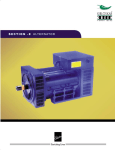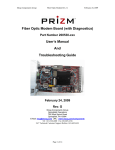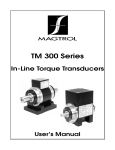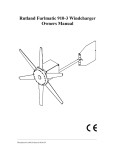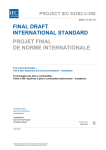Download technical manual (PDF 110k)
Transcript
OPERATING INSTRUCTIONS DESCRIPTION OF PLANT: Engine: Power Packs are supplied equipped with petrol engines. The engine manufacturer's instruction manual is supplied with the Power Pack, and should be consulted on all matters concerning the engine. Alternator: The alternator is a slip ring type, with built-in voltage regulator. Switched plug outlets are provided. COMPLETE UNIT: Rubber feet are fitted to the unit. These rubber feet must be kept clean and free of oil to prevent deterioration. Initial Starting: The Engine Instruction Manual should be read carefully, together with these instructions. It is extremely important that the unit is placed on level ground. Fill the sump with the correct grade of lubricating oil and the tank with the correct grade of fuel. Start the engine and run the unit without load for a few minutes, carefully checking that there are no lubricating oil or fuel leaks. After a few minutes operation without load, the engine will be running smoothly. It should be stopped and allowed to stand for five minutes. Check the engine oil level and top up as necessary, to replace that dispersed around the tappets, gears and crankshaft. WARNING: DO NOT RUN A PETROL ENGINE DRIVEN POWER PACK WITHIN A CLOSED ROOM, OR IN ANY PLACE WHERE THE EXHAUST GASES CANNOT ESCAPE. NEVER RUN A POWER PACK AT LESS THAN ITS RATED SPEED. PROTECTION AND CARE: Always change the sump oil as directed by the engine manufacturer. Failure to do this will result in rapid deterioration of the engine. As far as possible, keep the unit clean, out of the rain, and away from water. This will prevent rusting of components and trouble with ignition and the alternator. If the unit is covered, whilst in operation, make sure the engine and alternator get sufficient cool fresh air, and that both the exhaust gases and hot cooling air can get away from under the cover. NORMAL STARTING PROCEDURE: Check the lubricating oil sump level, and refill if required. Carefully fill the fuel tank, and avoid spillage. Never fill the fuel tank whilst the engine is running; sparks can cause explosions. Start the engine as directed by the engine manufacturer's instruction book, allowing it to warm up for about five minutes before applying load. LOADING THE POWER PACK: The maximum load applied to the set should not exceed the continuous load rating stamped on the alternator nameplate. 240V AC, single phase power packs, ' can be used to operate any appliance which could normally be connected to an AC mains supply, provided the appliance's current consumption is within the rated capacity of the Power Pack. Small induction motors which require a starting current greater than the alternators continuous rating, may be operated providing that the motor's continuous full load current does not exceed the alternator's continuous rating as indicated on the alternator rating plate. Whilst AC power packs will operate radio and television sets, there may be some interference caused by engine' ignition and alternator brush gear. Equipment can be fitted to minimise this interference. However, in fringe reception areas it may not be possible to completely eliminate the effect. Power Drive Systems Generator Control Specialists www.powersystems.com.au [email protected] Ph 0500 800 225 Fax 07 3350 1654 MAINTENANCE OF ENGINE: Engine Maintenance details are given in the engine manufacturer's instruction book. Special attention should be paid to the sections on engine cleanliness, maintenance periods and correct grades of fuel and oil. MAINTENANCE OF ALTERNATORS: The alternators are fitted with sealed ball bearings and these should need no attention. After 500 hours of operation the alternator carbon brushes should be checked for wear, and the carbon dust blown out of the machine. If the length of brush is less than 8mm it should be replaced. Before fitting new brushes inspect the slip-rings for scoring and/or wear, and if necessary dismantle the alternator and resurface. DISMANTLING THE ALTERNATOR: 1) Remove brushes. 2) Remove 4 bolts holding the alternator body to adaptor. 3) Carefully remove alternator body rearward over the rotor shaft. CAUTION - Do not allow the stator to hang on the rotor as this could result in damage to the rotor. 4) Remove the rotor by rotating same in an anticlockwise direction with the engine in a locked condition. Alternator Fails to Excite: Should the alternator fail to excite, check the brush gear to ensure good contact is being made between the brushes and sliprings. If the fault still persists it may be due to loss of residual magnetism of the, alternator. To re-excite the alternator, STOP PLANT and unclip plastic brush assembly cover, using a small 9V dry cell transistor battery, connect POSITIVE to the BOTTOM brass brush cap and NEGATIVE to the TOP brass brush cap for a period of approximately 10 seconds. WARNING: DO NOT REVERSE POSITIVE AND NEGATIVE CONNECTIONS OR DAMAGE TO THE SOLID STATE REGULATOR WILL OCCUR. Remove battery connections, replace plastic brush cover and start plant. If plant still fails to excite, STOP PLANT, carefully remove G.P.O. and check that oil wiring is secure, and the fuse mounted on the printed circuit board is not ruptured. NOTE: Blue and brown wires terminated in connector should not be disturbed. If fault cannot be located unit may need to be inspected by authorised service personnel. Power Drive Systems Generator Control Specialists www.powersystems.com.au [email protected] Ph 0500 800 225 Fax 07 3350 1654



